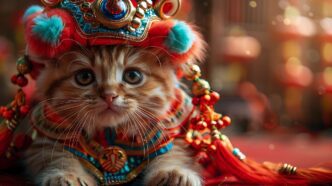KEY POINTS
- In Vedic Astrology, planetary mantras are sacred sound formulas that serve as a profound remedial measure to harmonize an individual’s life with the energies of the nine planets (Grahas).
- Each of the nine planets has a specific mantra that is chanted to mitigate its challenging influences while amplifying its blessings, with the practice traditionally performed at specific times and for 108 repetitions.
- The practice empowers individuals to actively engage with their astrological chart, using mantras to balance the influences of a weak or afflicted planet—such as the Sun for confidence or Saturn for discipline—to promote self-awareness and growth.
In the intricate cosmos of Vedic Astrology, the nine planets, or Grahas, are not merely celestial objects but powerful divine intelligences that choreograph our karmic journey. For individuals seeking to harmonize their lives with these cosmic forces, planetary mantras serve as the most profound and accessible remedial measure. These sacred sound formulas, chanted with intention and devotion, work to appease the Grahas, mitigating their challenging influences while amplifying their blessings. This ancient practice, performed at specific times and for a set number of repetitions, empowers anyone to actively engage with their astrological chart, transforming planetary energies from sources of fate into catalysts for profound self-awareness and growth.
What are Planetary Mantras?
The word mantra is derived from two Sanskrit roots: man, meaning “mind,” and tra, meaning “tool” or “instrument.” A mantra is, therefore, a tool for the mind—a sacred utterance designed to focus consciousness and channel divine energy. In the context of Jyotish, or Vedic Astrology, these are not generic prayers but specific sonic vibrations that have been cognized by ancient sages, or Rishis, to resonate perfectly with the frequency of a particular planet.
Vedic wisdom views the Grahas as living, breathing entities that dispense the fruits of our past actions, or karma. They are the cosmic agents of cause and effect. “Appeasing” a Graha does not mean bribing a deity; it means consciously aligning your personal energy field with the universal energy that the planet represents. Chanting a planet’s mantra is like tuning a radio to a specific station—it clears the static and allows you to receive its transmission clearly and constructively.
The Science and Spirit of Chanting
The effectiveness of mantra practice hinges on more than just mechanical repetition. The first step is setting a clear intention, known as sankalpa. Before beginning, one should mentally state the purpose of the chant, whether it’s to calm an anxious mind (Moon), boost career prospects (Sun), or navigate a difficult karmic period (Saturn).
Chants are traditionally repeated 108 times, a sacred number in Vedic cosmology. A japa mala, or rosary with 108 beads, is used to keep count, allowing the practitioner to focus on the sound rather than the number. While perfect Sanskrit pronunciation (ucchāraṇa) enhances the mantra’s potency, sincere effort and devotion are paramount. It is better to chant with a focused heart than to be paralyzed by the fear of mispronunciation.
Creating a sacred space is also beneficial. Choose a clean, quiet area where you will not be disturbed. The early morning hours, particularly the period known as Brahma muhurta (approximately 90 minutes before sunrise), are considered most auspicious for spiritual practices as the mind is calm and the atmosphere is sattvic, or pure.
Mantras for the Nine Grahas
Each of the nine Grahas governs specific areas of life. By identifying which planet is weak, afflicted, or currently active in your chart through its dasha (planetary period), you can choose the appropriate mantra to bring balance.
Surya (The Sun): The Royal Planet of Soul and Authority
The Sun represents our soul (Atma), vitality, ego, confidence, and authority. It governs our relationship with our father, the government, and our capacity for leadership. A strong Sun bestows a noble character and high status.
Chanting the Sun’s mantra is recommended for those with a weak or afflicted Sun in their birth chart, which can manifest as low self-esteem, health issues, or conflicts with authority figures. It is particularly potent when chanted on Sundays, during the Sun’s planetary hour, or throughout a Sun Mahadasha.
- Bija (Seed) Mantra: Om Hram Hreem Hroum Sah Suryaya Namah
- Navagraha Mantra: Om Japa Kusuma Sankasham Kashyapeyam Mahadyutim Tamorim Sarva Papaghnam Pranathosmi Divakaram
Regular practice can boost confidence, improve health and vitality, and foster better relationships with figures of authority.
Chandra (The Moon): The Planet of Mind and Emotions
The Moon governs the mind (Manas), emotions, memory, and our sense of public and social well-being. It represents the mother, nurturing, and our inner comfort. A balanced Moon provides emotional stability and strong intuition.
If the Moon is afflicted, it can lead to anxiety, mood swings, and emotional turmoil. Chanting the Moon’s mantra is highly beneficial for calming the mind and is best performed on Mondays, especially during the evening.
- Bija (Seed) Mantra: Om Shram Shreem Shroum Sah Chandraya Namah
- Navagraha Mantra: Dadhi Shankha Tusharabham Kshirodarnava Sambhavam Namami Shashinam Somam Shambhor Mukuta Bhushanam
This practice enhances emotional intelligence, promotes tranquility, and strengthens one’s capacity for empathy and care.
Mangal (Mars): The Planet of Energy and Action
Mars is the planet of energy, courage, action, and determination. It governs siblings, property, physical strength, and passion. A well-placed Mars gives one the drive and initiative to overcome obstacles.
An afflicted Mars can manifest as aggression, impatience, accidents, or conflict. Its mantra is a powerful remedy for managing anger and channeling energy constructively. The ideal day for this practice is Tuesday. It is often recommended for those with Mangal Dosha in their charts.
- Bija (Seed) Mantra: Om Kram Kreem Kroum Sah Bhaumaya Namah
- Navagraha Mantra: Dharani Garbha Sambhutam Vidyut Kanti Samaprabham Kumaram Shakti Hastam Tam Mangalam Pranamamyaham
Chanting this mantra helps in resolving disputes, especially those related to property, and instills the courage to face life’s battles.
Budha (Mercury): The Planet of Intellect and Communication
Mercury, the divine messenger, rules our intellect (Buddhi), communication, speech, learning, and commerce. It represents our analytical abilities and adaptability. A strong Mercury grants wit, eloquence, and business acumen.
When Mercury is weak or afflicted, it can cause communication problems, learning difficulties, or indecisiveness. Its mantra is excellent for students, writers, speakers, and business people. The best day to chant is Wednesday.
- Bija (Seed) Mantra: Om Bram Breem Broum Sah Budhaya Namah
- Navagraha Mantra: Priyangu Kalika Shyamam Rupena Pratimam Budham Saumyam Saumya Gunopetam Tam Budham Pranamamyaham
This practice sharpens the intellect, improves communication skills, and brings success in educational and commercial ventures.
Guru (Jupiter): The Planet of Wisdom and Expansion
Jupiter, known as Guru, is the great benefic. It represents wisdom, higher knowledge, teachers, wealth, and good fortune. In a woman’s chart, it signifies the husband. It governs expansion, optimism, and divine grace.
A weak Jupiter can limit opportunities and lead to a lack of faith or financial struggles. Chanting its mantra attracts prosperity, wisdom, and guidance. The ideal day for this practice is Thursday.
- Bija (Seed) Mantra: Om Gram Greem Groum Sah Gurave Namah
- Navagraha Mantra: Devanam Cha Rishinam Cha Gurum Kanchana Sannibham Buddhi Bhutam Trilokesham Tam Namami Brihaspatim
Regular chanting can expand one’s horizons, attract mentors and financial opportunities, and deepen spiritual understanding.
Shukra (Venus): The Planet of Love and Luxury
Venus governs love, relationships, marriage, beauty, arts, and all forms of luxury and sensual pleasure. In a man’s chart, it represents the wife. A strong Venus bestows charm, refinement, and artistic talent.
An afflicted Venus can cause difficulties in relationships, a lack of material comfort, or overindulgence. Its mantra helps harmonize relationships and attract beauty and abundance. The best day for this practice is Friday.
- Bija (Seed) Mantra: Om Dram Dreem Droum Sah Shukraya Namah
- Navagraha Mantra: Hima Kunda Mrinalabham Daityanam Paramam Gurum Sarva Shastra Pravaktaram Bhargavam Pranamamyaham
This practice enhances creativity, improves romantic life, and fosters an appreciation for the beauty and comfort in life.
Shani (Saturn): The Planet of Discipline and Karma
Saturn is the great taskmaster, the lord of karma, discipline, and time. It represents structure, responsibility, longevity, and service. Though often feared, Saturn’s influence brings maturity and spiritual growth through perseverance.
Its mantra is most critical during challenging Saturn transits like the Sade Sati or a Shani Mahadasha. Chanting helps one endure hardship with patience and grace. The ideal day is Saturday.
- Bija (Seed) Mantra: Om Pram Preem Proum Sah Shanaishcharaya Namah
- Navagraha Mantra: Neelanjana Samabhasam Ravi Putram Yamagrajam Chhaya Martanda Sambhutam Tam Namami Shanaishcharam
This powerful chant cultivates discipline, reduces the severity of karmic lessons, and ultimately brings profound stability and wisdom.
Rahu (The North Node): The Planet of Ambition and Illusion
Rahu is not a physical body but a shadow planet representing worldly ambition, obsession, and unconventional desires. It governs technology, foreign influences, and sudden, dramatic events. Rahu can grant immense material success but can also create illusion (Maya).
The mantra for Rahu helps ground its insatiable energy, providing clarity and protecting against deception. It is particularly helpful during a Rahu Mahadasha and should be chanted on Saturdays.
- Bija (Seed) Mantra: Om Bhram Bhreem Bhroum Sah Rahave Namah
- Navagraha Mantra: Ardha Kayam Maha Viryam Chandraditya Vimardanam Simhika Garbha Sambhutam Tam Rahum Pranamamyaham
This practice helps one navigate worldly ambitions without losing their spiritual center and can bring success in fields related to technology or foreign lands.
Ketu (The South Node): The Planet of Spirituality and Detachment
Ketu, the other shadow planet, represents spirituality, detachment, intuition, and past-life karma. It is the force that pushes us toward liberation (Moksha) by severing our attachments to the material world.
An afflicted Ketu can cause confusion, feelings of aimlessness, or sudden losses. Its mantra enhances spiritual insight and helps in letting go of the past. The ideal day to chant is Tuesday.
- Bija (Seed) Mantra: Om Sram Sreem Sroum Sah Ketave Namah
- Navagraha Mantra: Palasha Pushpa Sankasham Taraka Graha Mastakam Raudram Raudratmakam Ghoram Tam Ketum Pranamamyaham
Chanting this mantra sharpens intuition, aids in healing deep-seated karmic issues, and guides the soul toward its ultimate purpose.
A Final Thought on Cosmic Harmony
Planetary mantras are far more than a simple astrological fix; they are a profound spiritual practice that empowers us to become active co-creators of our destiny. By engaging with the Grahas through these sacred sounds, we move from being passive recipients of cosmic energies to conscious participants in our own evolution. This practice fosters a deep and abiding connection between our individual self and the universal consciousness, leading not just to a smoother life path, but to greater balance, wisdom, and inner peace.








